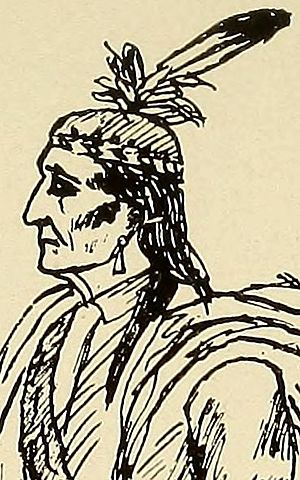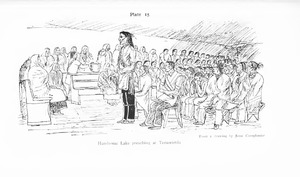Handsome Lake facts for kids
Quick facts for kids
Handsome Lake
|
|
|---|---|

Drawing by Jesse Cornplanter
|
|
| Born |
Hadawa'ko
1735 |
| Died | August 10, 1815 |
| Nationality | Seneca |
| Other names | Sganyadái:yo; Sganyodaiyo; Θkanyatararí•yau• |
| Occupation | Prophet |
| Known for | The Code of Handsome Lake |

Handsome Lake (in Cayuga language: Sganyadái:yo, in Seneca language: Sganyodaiyo) (1735 – August 10, 1815) was an important Seneca religious leader. He was part of the Iroquois people, also known as the Haudenosaunee. He was the half-brother of Cornplanter, a Seneca war chief.
Handsome Lake was a prophet who helped bring back traditional religion for the Haudenosaunee (People of the Longhouse). This group is also known as the Six Nations Iroquois Confederacy. He shared a message that mixed old Haudenosaunee beliefs with new rules. These rules were meant to help his people after a long time of cultural changes due to colonization. His message became known as the "Code of Handsome Lake" and is still followed today.
Contents
Early Life of Handsome Lake
Handsome Lake was born around 1735. His birth name was Hadawa'ko, which means "Shaking Snow." He was born in a Seneca village called Canawaugus. This village was on the Genesee River, near what is now Avon, New York.
Not much is known about his parents. His mother, Gahonnoneh, later had another son, Cornplanter, who became Handsome Lake's half-brother. Handsome Lake was born into his mother's Turtle clan. The Iroquois people follow a matrilineal system, meaning family lines are traced through the mother. Later, he was adopted by people from the Wolf clan.
Handsome Lake grew up when the Seneca nation was doing very well. They were successful because of the fur trading. However, he saw his society slowly change and face many difficulties. Other famous relatives in his family included Governor Blacksnake, Red Jacket, and Half-Town.
His Work and Challenges
In 1794, Handsome Lake signed a treaty with the United States. This was known as the Pickering Treaty. He also visited Washington, D.C., in 1802 with Cornplanter.
The Iroquois, or Haudenosaunee, faced many problems that made their spirits low. In the early 1700s, they controlled a large part of what is now the midwestern United States. They had gained this land by fighting other tribes in wars like the Beaver Wars.
After the American Revolution, the Haudenosaunee lost most of their land. This was in New York and Pennsylvania. They were forced to live on smaller areas called reservations. Some even moved to Canada. This happened because they had supported the British during the revolution.
Even though these reservations included good land, they were small and separated. Large areas of land were set aside for American settlers. This was part of what was called the Holland Purchase. This loss of land came after many years of social problems. These problems included widespread diseases and major wars.
Bringing the Good Word (Gaiwiio)
In 1799, Handsome Lake became very sick. During this time, he had special visions. These visions gave him the power to become a prophet. In his vision, three spirit messengers warned him. They gave him important ideas he needed to share with his people. They told him to encourage learning English and protecting their land.
When he got better, he started sharing a message called Gaiwiio, or the "Good Word." He spoke out against drinking too much and other harmful practices. His message created a set of rules for living. This was later called the Code of Handsome Lake. Today, it is known as the Longhouse Religion.
Handsome Lake wanted to remove bad actions from his society. He urged his people to change their ways. He insisted that Iroquois people should stop:
- Drinking too much alcohol.
- Not taking care of their families.
- Selling too much of their land.
- Using too many resources.
- Harmful farming methods.
- Practicing bad magic.
Handsome Lake's Way of Life became very successful. This was because his code mixed traditional Iroquois ways with values from the Quakers. It is not clear how much Handsome Lake knew about Christianity before his visions.
His new way of life focused on surviving without losing the Iroquois identity. It also recognized that they needed to change to live in a changing world. Most people agreed with Handsome Lake's ideas. However, some people did not like the code. They thought Handsome Lake was giving up their old ways. They saw his new ideas as abandoning their history and giving in to Quaker beliefs.
The Code of Handsome Lake was a very successful movement. It combined traditional Iroquois values with some Christian ideas. In 1803, then-President Thomas Jefferson supported Handsome Lake's code. With help from Handsome Lake’s relatives, his visions were written down. They were published in 1850. The Code of Handsome Lake is still practiced by the Seneca people. It is seen as a traditional Native American way of life. Starting in the 1820s, the Code was traditionally recited every September at Tonawanda in the Seneca Nation.
A Story About How America Was Discovered
"How America Was Discovered" is a story told by Handsome Lake. It was written down by Arthur C. Parker. The story is about a young minister who meets someone he thinks is the Lord. This person asks him to go to a new land. He is told to bring cards, money, a fiddle, whiskey, and bad influences. In return, the minister would become rich.
The young minister found Christopher Columbus. With his crew, they traveled to the Americas. They returned to report what they had seen. This led to many people from Europe moving to the Americas. Along with the people came the five things that helped cause problems for the native people. The story ends by revealing that the "Lord" in the gold castle was actually the devil. Even the devil knew that what he had caused was wrong.
See also
 In Spanish: Handsome Lake para niños
In Spanish: Handsome Lake para niños
- Tenskwatawa, Shawnee Prophet
- Wovoka, founder of the Ghost Dance movement
- Smohalla, dreamer-prophet associated with the Dreamers movement in the Pacific Northwest
- Native American temperance activists

